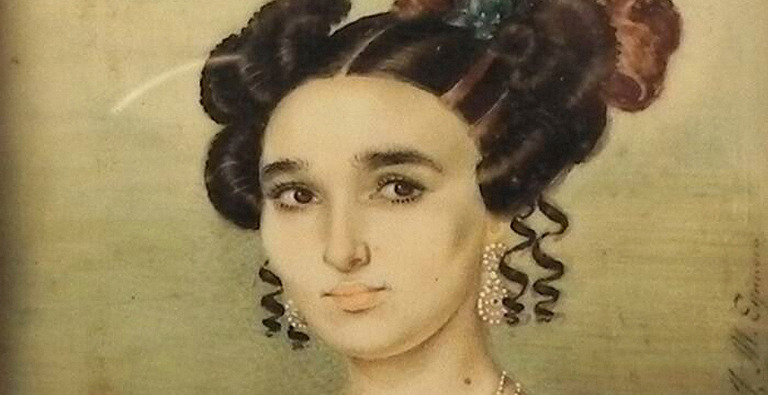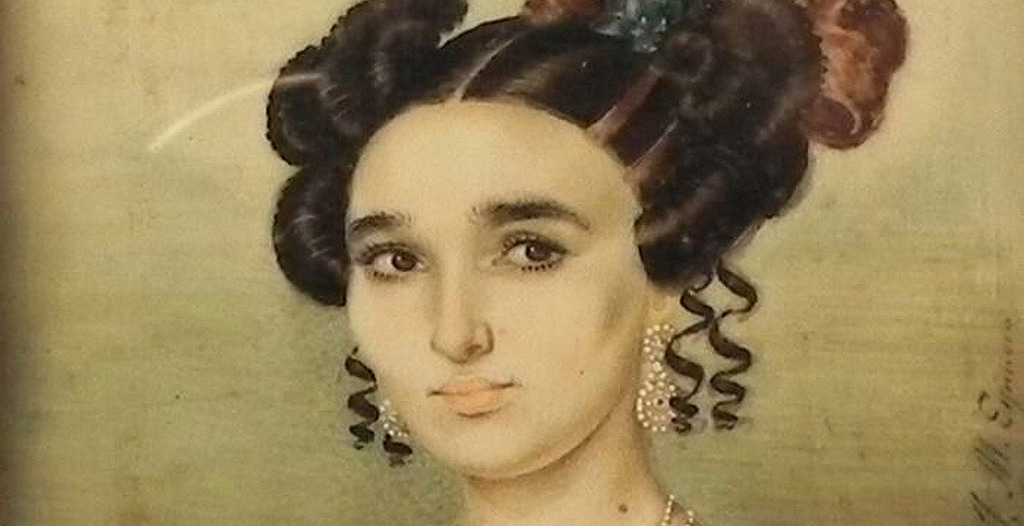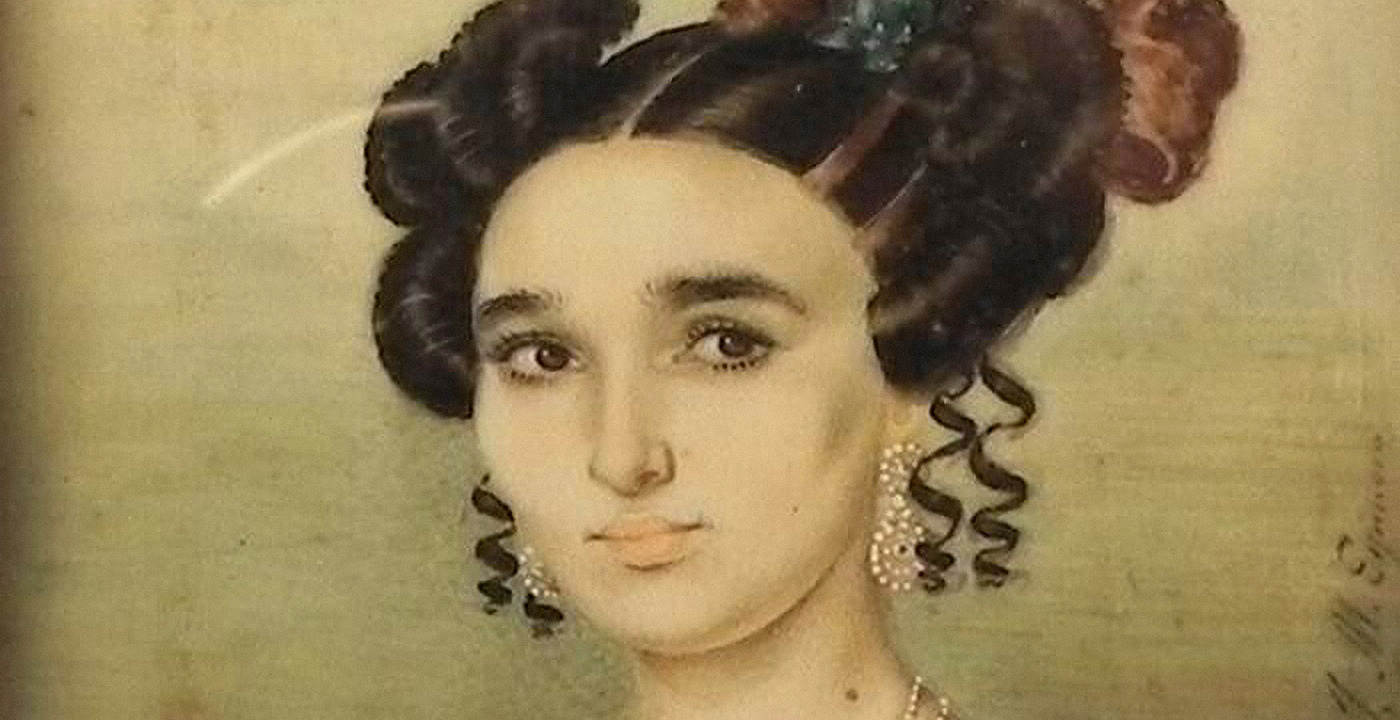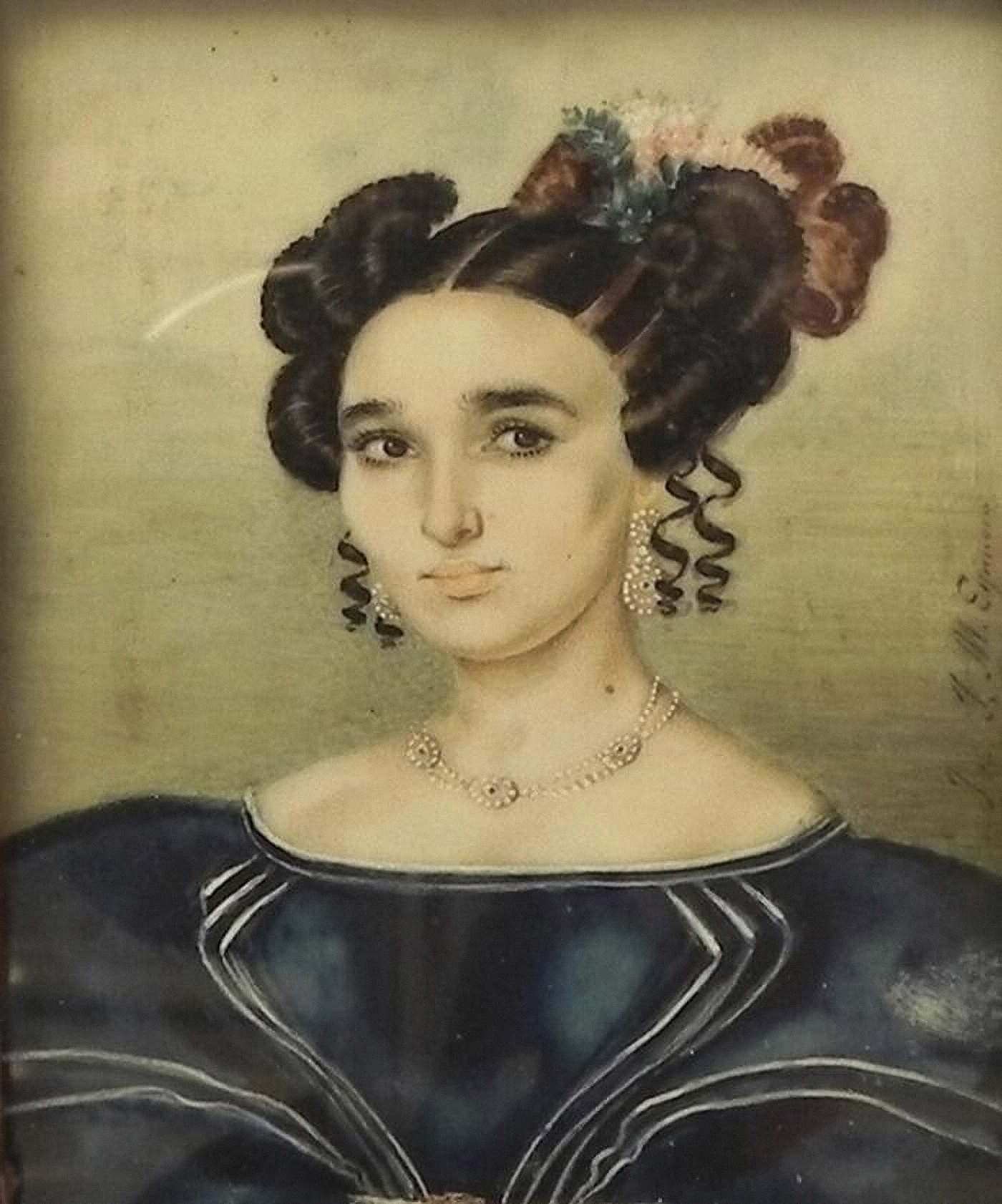Birth
December 1797
Education
Sáenz learned to read and write from the nuns who raised her at the Monasterio de la Concepción in Quito.
Death
November 23rd, 1856 in Paita, PeruReligion
Roman CatholicManuela Sáenz de Thorne was Simon Bolívar’s official archivist and consort. During her life she became known as “la Libertadora,” a moniker that originated among the soldiers of the Colombian Army. This name reflected not only the men’s recognition of Sáenz’s firm loyalty to and close association with Bolívar but their respect for her willingness to help needy or troubled individuals who sought her assistance and for whom she sometimes interceded. By the time of her arrival in Bogotá (1827), Sáenz was known informally as an advocate of the Army’s rank-and-file and as someone to whom they could appeal for support in matters such as requests for a military pardon.
Since at least c. 1980, Sáenz’s legacy has been kept alive by Ecuadorian feminists who claim her as their spiritual foremother and as a symbol of women’s struggles for freedom, gender equality and social justice.
Personal Information
Name(s)
Manuela Sáenz Aizpuru
Date and place of birth:
December 1797 in Quito, Ecuador (day uncertain)
Date and place of death:
November 23, 1856 in Paita, Peru
Mother: Joaquina Aizpuru
Father: Simon Sáenz de Vergara
Marriage and Family Life
Spouse:
James Thorne (married July 27, 1817 in Lima; his birthdate unknown; died Feb. 16, 1847). The couple had no children. Sáenz’s half-siblings included María Josefa, María Manuela, Ignacio and José Maria Sáenz del Campo, all offspring of Simon Sáenz & his legal wife, Juana Maria del Campo. Her only surviving maternal relative was an aunt, Ignacia Aizpuru (born c. 1757, d. Dec. 1845).
Education
Beyond receiving a basic education from the Concepcionistas, Sáenz also likely studied with the nuns at Quito’s Convent of Santa Catalina (a religious order founded by Saint Catherine of Siena). By the time of her encounter with Bolívar, she had learned French, read some of the writings of Jean-Jacques Rousseau and become a fan of Rousseau’s popular sentimental novel, Julie ou La Nouvelle Heloïse; Bolívar acknowledged this in one of his few surviving letters to Sáenz, referring to Julie/Heloise as her personal “heroine”.
Religion
Roman Catholic
Transformation(s)
Sáenz’s ambitions were shaped in part by circumstances of her origin and upbringing. Given that her birth was the inadvertent result of an affair between her married father, a locally-prominent Spanish merchant and single mother, daughter of a respected government lawyer, Sáenz spent her tender years among the Concepcionista nuns to whom her parents had entrusted her; these raised her as a “foundling (hija exposita)” in order to disguise the dishonour associated with the child’s out-of-wedlock birth status and thus protect parental family reputations. While the young girl later was incorporated into her father’s family, she never knew her mother (who likely died in childbirth) nor was fully accepted by her Aizpuru relatives; one sign of this was her aunt Ignacia’s reluctance to recognize her later claim to a maternal inheritance. Sáenz’s insistence on the claim reflected not only her self-confidence but her awareness of both her legal rights and creole-Spanish (upper-class) origin or lineage. After entering into an arranged marriage with a prosperous British merchant based in Lima, Sáenz also joined the cause of Peruvian and Spanish American independence. This marked a turning-point in her life, ultimately distancing her from her royalist husband and leading to her extramarital relationship, starting in 1822, with Caracas-born revolutionary leader General Simón Bolívar. Sáenz’s passion for Bolívar—and, desire to support both his anti-Spanish struggle and ambitious vision of a free and united Spanish America--inspired her subsequent political career including her roles as Bolívar’s official staff archivist, confidante and follower. It continued to inspire her political activities for two decades after Bolívar’s death in 1830.
While Sáenz never sought to alter her society’s gendered assumptions, she challenged them inadvertently by plunging into the traditionally masculine public sphere--including the new, rough-and-tumble world of competitive politics. She was not only one of Bolívar’s closest followers, but, his boldest defender. She won the respect of many through her willingness to confront his opponents; a famous example was her thwarting of a September 25, 1828 assassination attempt against him inside the presidential palace. Sáenz later defended Bolívar’s public reputation by openly rebutting his press critics and, after his resignation of the Colombian presidency (1830), actively conspiring to restore him to power.
Contemporaneous Network(s)
Scattered epistolary evidence shows that in every city she resided in (i.e. Lima, Quito, Bogotá, Paita), Sáenz maintained a network of friends of both sexes. Friends proved critical to Sáenz’s ability to endure the misfortunes that afflicted her in the decades after Bolívar’s death; these included political exile from Colombia (renamed New Granada) and Ecuador, chronic indebtedness and impoverishment. In the small northern Peruvian port city of Paita where Sáenz found refuge in 1835, for example, the women of the Lamas y Godos family assisted her in her efforts to rebuild her life and become part of the local community. Paita’s American consul (Alexander Ruden) and various Ecuadorian émigrés offered her their financial assistance, enabling her to survive years of chronic penury. Sáenz’s most noteworthy network, however, were the Bolívarians. Consisting of close followers of Bolívar, mainly military officers who had served under him and whom Sáenz knew personally—and considered as members of her family--these helped her retain a sense of meaning and purpose during her long, often lonely residence in Paita. Sáenz corresponded regularly with them, especially with General Juan Jose Flores, first president of Ecuador with whom she also collaborated on several political projects through the mid-1840s.
less
Significance
Works/Agency
These consist primarily of her surviving correspondence most of which may be found in various archives, in diverse academic journals and in a volume of her letters to General Juan Jose Flores.
Reputation
During her time as Bolívar’s official archivist and consort, Sáenz became known as “la Libertadora,” a moniker that originated among the ordinary men and junior officers of the Colombian Army. This name reflected not only the men’s recognition of Sáenz’s firm loyalty to and close association with Bolívar but their respect for her willingness to help needy or troubled individuals who sought her assistance and for whom she sometimes interceded. By the time of her arrival in Bogotá (early 1827), Sáenz was known informally as an advocate of the Army’s rank-and-file and as someone to whom they could appeal for support in matters such as requests for a military pardon. The positive reputation she developed among Bolívar’s followers (both military and civilian), however, was soon matched by the negative one she developed among the allies and adherents of his major rivals, especially Colombian Vice-President Francisco de Paula Santander. In the late-1820s, Sáenz became a lightening rod in an escalating power struggle between the Bolívarians and “Santanderistas.” She became a target of Santanderista-inspired rumor and gossip, a trend rooted in distrust of Bolívar’s government as well as misogynistic fear of women who wielded behind-the-scenes political influence. After Bolívar went into exile (dying along the way in Santa Marta), the new Santanderista administration forcibly expelled Sáenz from Bogotá, alleging she had conspired to overthrow it and embodied a threat to “public morality.” The Ecuadorian government followed suite, arguing that Sáenz had allied herself with its opponents and thus posed a risk to public order.
The Libertadora vigorously resisted such claims and allegations. Although obliged to settle in remote Paita (1835), she would spend many years seeking to vindicate her reputation as, in her own words, “a friend of order.” Moreover, while her death in a diphtheria epidemic went largely unnoticed—and, was followed by decades of silence about her among historians—public recognition of her role and significance would develop in the 20th century.
Legacy and Influence
Institutions & objects named after her:
- Residencia Universitaria ‘Manuela Sáenz’,Universidad Andina Simon Bolívar –Ecuador (Quito) https://www.uasb.edu.ec/nosotros/campus/
- Casa-Museo Manuela Sáenz (Quito)
www.museosquito.gob.ec or https://museo-manuela-Sáenz.negocio.site/#summary
- Distrito de Policia ‘Manuela Sáenz’ (Quito). ministeriodegobierno.ec
- Bust of her likeness at the National Pantheon of Venezuela (Caracas) where, in 2010, her symbolic remains were officially buried next to Bolívar’s. panteonnacional.gob.ec
Her legacy:
Since at least c. 1980, Sáenz’s legacy has been kept alive by Ecuadorian feminists who claim her as their spiritual foremother and as a symbol of women’s struggles for freedom, gender equality and social justice. It has been celebrated by national governments keen to burnish their patriotic credentials and political legitimacy. This is especially the case in Ecuador. Indeed, thanks to Ecuadorian writers who, in the mid-20th century, revived their country’s memory of her, celebrating her closeness to Bolívar and role as a protagonist of Spanish American independence, Manuela Sáenz has become an icon of national identity; she is today embraced by Ecuadorians across the political spectrum. Much like her famous lover, she also now dwells in the realm of myth and legend. Sáenz in the last half-century has been a source of inspiration for diverse writers, poets and artists (including filmmakers); within the so-called Bolívarian nations of Venezuela, Colombia and Ecuador especially, she has entered the pantheon of pan-Spanish American heroes.
less
Controversies
Controversy
Around the mid-20th century, the long silence surrounding Manuela Sáenz gave way to writings that reflected two broad camps of interpretation about Sáenz’s role in Spanish American history: the “bad girl” vs the “heroine” camps. Echoing the criticism of her and Bolívar’s opponents, authors in the first camp stressed Sáenz’s unorthodox and transgressive behaviour. Some deplored this behaviour, characterizing it-- e.g. her habits of riding about town in masculine garb (a military uniform) and participating actively in politics—as crass and unlady-like, proof that Sáenz was disreputable. Indeed, “bad girl” authors portrayed her, overall, as little more than a prostitute and liability for Bolívar. A few tried to explain Sáenz’s flouting of gender norms as the result of a confused sexual identity; early 20th century Peruvian author Ricardo Palma, for example, stated that Sáenz was “a mistake of nature whose masculine spirit and aspirations were embodied in feminine forms.” Building on this theme of deviancy, author Alberto Miramon suggested that Sáenz’s political assertiveness and alleged “continuous infidelities” were the result of “nymphomania.” By contrast, authors of the “heroine” camp have stressed Sáenz’s courage and selfless devotion to Bolívar. Reflecting in part a growing pride in Spanish America’s common revolutionary (and, Bolívarian) heritage, they’ve highlighted her saving of his life from the notorious September 25, 1828 attackers. They’ve portrayed her as a quasi-Mary Magdalene who redeemed her “sins” through her love for Bolívar and service to the independence cause. The most important example of this heroic-nationalist interpretation remains Alfonso Rumazo Gonzalez’s biography, Manuela Sáenz: La Libertadora del Libertador (1944; and subsequent editions). The latter stands out for its pioneering effort to tell Sáenz’s life-story and view it in historical perspective. Pamela Murray’s more recent and scholarly For Glory and Bolívar: The Remarkable Life of Manuela Sáenz (2008) both builds on it and supercedes it through an unprecedented use of Sáenz’s own correspondence and other primary sources including evidence from various archives; it also offers a more modern, nuanced interpretation of Sáenz by incorporating insights from contemporary scholarship on the history of Spanish American women and gender.
less
Bibliography
Primary (selected, published & on microfilm):
Academia Colombiana de Historia (comp.). “Documentos inéditos: Sumaria información instituida por orden del Supremo Gobierno para averiguar los hechos escandalosos y criminales con que Manuela Sáenz ha tratado de perturbar el orden y tranquilidad públicas (julio-agosto 1830).” Boletín de Historia y Antigüedades (Bogotá) 47, May-June 1960, 373-402.
Archivo del Libertador. Caracas: Casa Natal, 1961. Microfilm rolls 27, 34 & 42.
Archivo Nacional de Historia del Ecuador (eds.). “Expediente promovido por Doña Manuela Sáenz sobre su filiación y calidad y poder general [de] Manuela Sáenz y Thorne al Presbitero Don Jose Manuel Flores.” Arnahis: Organo del Archivo Nacional de Historia (Quito), 3 (1970), 87-91.
Lecuna, Vicente (ed.). “Papeles de Manuela Sáenz,” Boletin de la Academia Nacional de la Historia (Caracas), V. 28, Oct-Dec. 1945, 494-525.
Villalba, Jorge F. (ed.), Manuela Sáenz: Epistolario (Quito: Banco Central del Ecuador, 1986).
Despatches from United States Consuls in Lima, 1823-1854. Washington, D.C.: NARA, 1949. Microfilm roll 1.
Despatches from United States Ministers to Colombia, 1820-19906. Washington, D.C.: National Archives, 1955. Microfilm roll 8.
Archival Resources (selected):
Archivo Histórico del Banco Central, Quito. Fondo Jijón y Caamaño, 1ª Serie y 5ª Serie (on microfilm).
United Kingdom National Archives, Kew. Foreign Office section including FO 18, FO 135, FO 61, FO 177, & FO 357.




Comment
Your message was sent successfully